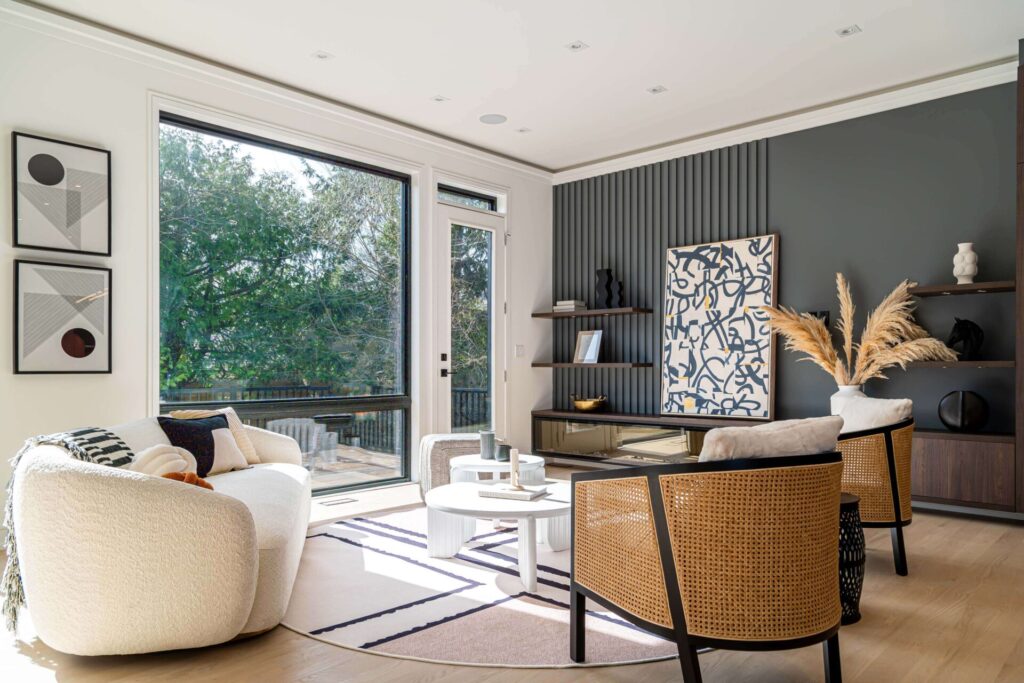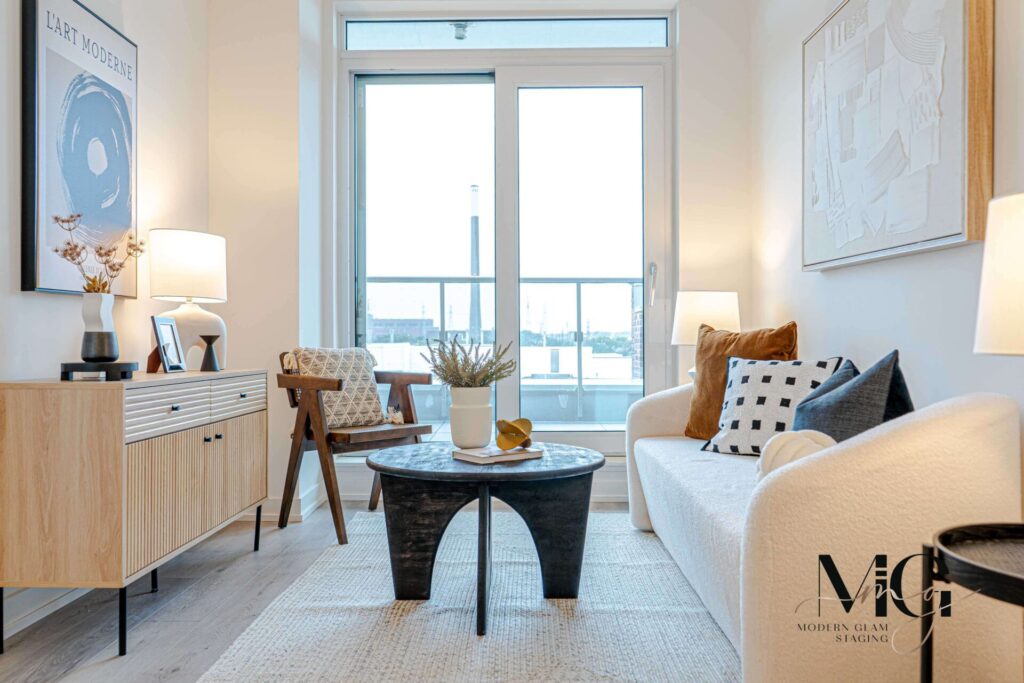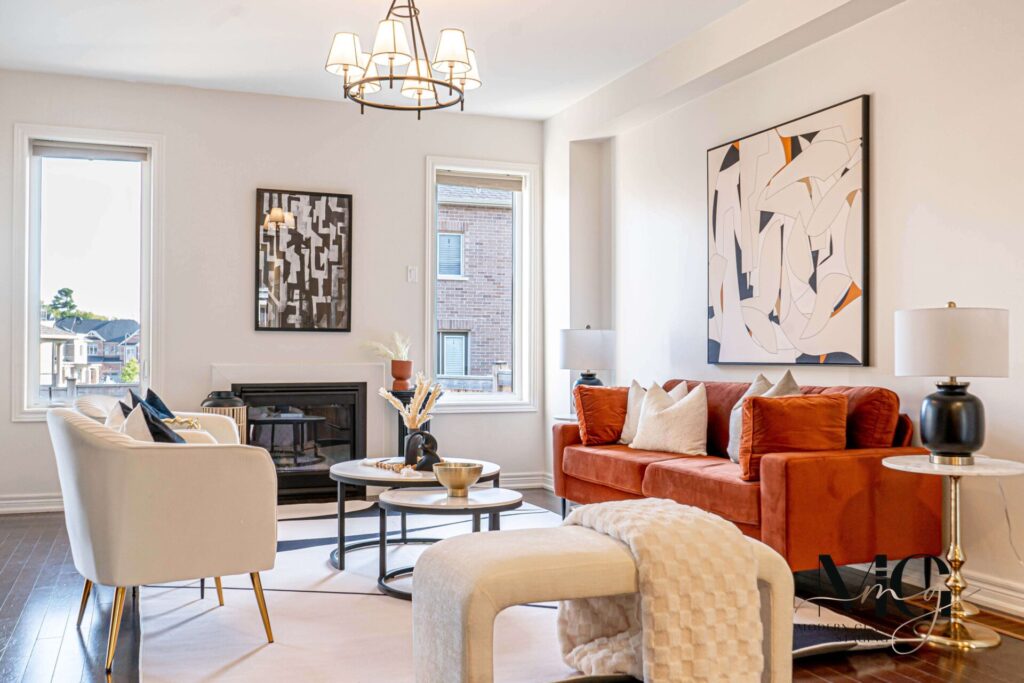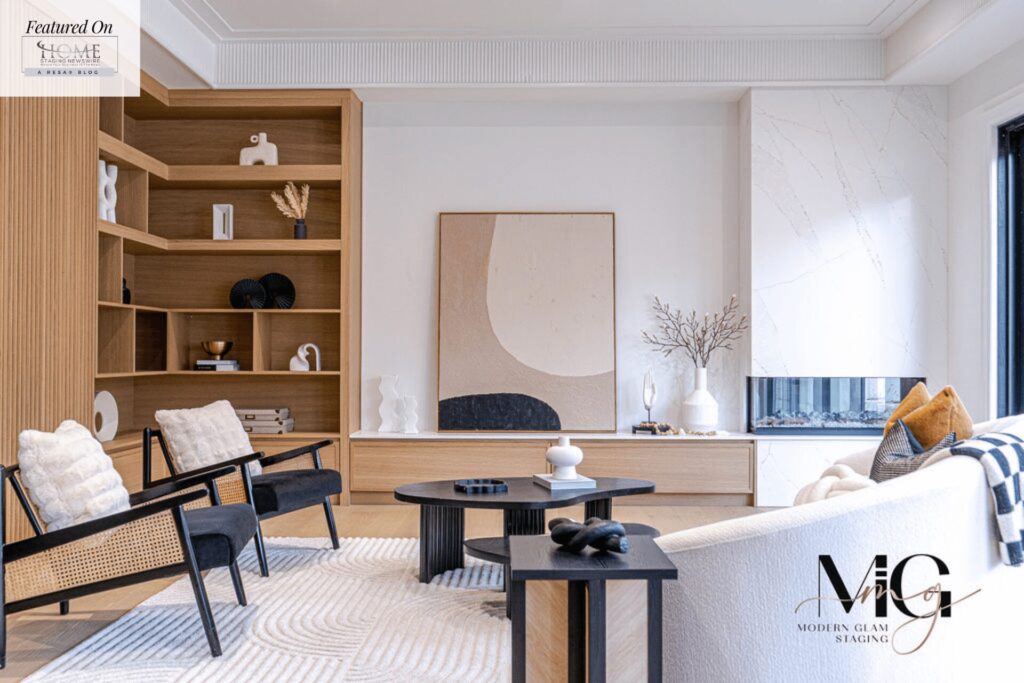Ida Liang‘s journey into staging unfolded naturally, stemming from her deep-rooted passion for crafting furniture, infusing seasonal elements into her home, and constantly rearranging her surroundings to evoke fresh aesthetics.
After the successful sale of her own home, she recognized the profound impact her staging endeavors had on its outcome. The influx of glowing reviews commending her staging, which she had undertaken herself despite lacking professional training, sparked a revelation: Why not transform this passion into a thriving business?
Witnessing the transformative process of homes evolving from their initial state to stunning, staged spaces became my driving force.
Inspired by this epiphany, Ida embarked on a journey to refine her skills and delve deeper into professional techniques by enrolling in an Interior Decorating program and eventually creating Modern Glam Staging to help the Toronto agents and homeowners with their staging and design needs.
I am continually inspired by the ability to breathe new life into spaces and create environments that evoke emotion and captivate potential buyers.
The Home Stager’s Perspective: A Conversation with Ida Liang
Q: How does your commitment to RESA®, the exclusive nonprofit trade association for stagers, align with your professional goals and values?
Ida: Our commitment to RESA® reflects our dedication to professionalism, excellence, and continuous learning in the staging industry.
Aligning with RESA® allows us to stay updated on industry trends, uphold ethical standards, and deliver exceptional service to our clients. Our affiliation underscores our belief in the transformative power of staging and our commitment to excellence in every aspect of our work.
Q: Take us back to your very first day on the job as a home stager. What were your feelings, expectations, and the most memorable moments from that day?
Ida: My first day on the job as a home stager was nothing short of exhausting. I vividly recall the frustration, the hours spent meticulously detailing my designs, and the sweat my team and I poured into the project.
Striving for perfection, I found myself constantly switching items, rearranging every piece of furniture, and scrutinizing every angle until the sun began to set, and I finally felt confident in our work.
Despite the fatigue, the results were beyond words. I’ll never forget the moment when the client arrived after we had completed the staging. The stunned expression on her face spoke volumes – she was speechless, surprised, and ultimately grateful for entrusting us with her project, despite our newcomer status in the industry.It was a moment of validation and motivation, affirming that our hard work and dedication had paid off, and that we were on the right path to making a meaningful impact in the world of staging.
Q: How has your perception of the staging industry evolved since you started?
Ida: My perception of the staging industry has shifted significantly, particularly in recognizing its increasing importance in the real estate market.
Following the pandemic, many families have redirected their savings towards renovating their interiors, aiming for fresher, more modern, and upscale homes. In this context, staging has emerged as a crucial element in ensuring that properties stand out in the competitive market.
By utilizing the most contemporary furnishing items, our staging elevates these renovations to a new level, enhancing the overall appeal of the property. This is especially pertinent considering that the majority of potential buyers are from younger generations, whose expectations for aesthetics are notably high. As such, staging has evolved from being a mere enhancement to becoming an essential component in meeting the demands of today’s discerning buyers.

ALL PHOTOS PROVIDED BY Modern Glam Staging
Q: Would you share some insights into your creative process? Where do you typically find inspiration for your staging designs, and how do you translate that into your work?
Ida: My creative process draws inspiration from various sources, with interior and fashion magazines being a primary influence. These publications consistently showcase the latest trends in interior styles, items, color schemes, and popular preferences, providing valuable insights into current design aesthetics.
I particularly enjoy crafting asymmetrical designs, as they offer a more personalized and dynamic look compared to traditional staged arrangements. Experimenting with asymmetry allows me to express my creativity and apply different decorating techniques, resulting in spaces that feel authentic and captivating to potential buyers.
Q: Can you recall a particularly challenging staging project? What obstacles did you face, and how did you overcome them? What did you learn from that experience?
Ida: One memorable and challenging staging project stands out vividly in my mind. It involved a client who already had a beautifully decorated home, and our plan was to declutter some items and switch a few large furniture pieces to enhance the space. We agreed on-site to incorporate a brighter and more youthful color palette to uplift the ambiance of her aged home. However, after completing the staging, she conveyed her dislike for the color yellow and requested a complete redesign.
In that moment, I realized the importance of managing client expectations and effectively communicating the purpose of staging. I explained to her that staging is not about personal preferences but about creating a captivating space that appeals to potential buyers and showcased our past successful projects featuring similar yellow accents (highlighting their positive impact on buyers’ perceptions).
Ultimately, the client trusted my expertise, and the results were remarkable. A potential buyer fell in love with the home on the first visit and made an offer on the same day. Witnessing the client’s joy and gratitude reaffirmed the significance of staying true to my design vision and effectively communicating its value to clients.

Q: Staging often involves collaboration with real estate agents. Could you share some insights into how effective communication and partnership between stagers and agents can lead to successful property sales?
Ida: It begins with having thorough discussions with agents to gain insights into the property’s neighborhood and the potential buyer demographics. Understanding the specific features and amenities that prospective buyers are seeking is crucial.
For example, will there be growing families in the area who may prioritize a nursery? working couples in need of a spacious home office?By incorporating these insights into our staging design, we can tailor the presentation to resonate with potential buyers, effectively highlighting the property’s most appealing features. This approach ensures that the staging speaks directly to the needs and preferences of the target market, ultimately leading to more successful property sales.
Q: Staging can transform a property, but it’s not just about aesthetics. How do you balance design principles with the practical aspects of making a home more marketable?
Ida: Particularly in the wake of the pandemic, there’s been a notable shift in buyer preferences towards more spacious properties. Given the high costs associated with purchasing a home today, it’s crucial to help buyers envision a space that maximizes functionality and offers a sense of openness.
Strategically arranging furniture and optimizing layouts, staging can create the perception of a more spacious and functional home within the constraints of the property’s size. This not only enhances the property’s appeal but also helps buyers see the potential in their budget, making them feel they can acquire a home that is both practical and larger than they initially imagined.
Q: The staging industry often requires adaptability and flexibility. How do you stay current with market demands and changing client preferences? What strategies do you use to continuously improve your skills and stay competitive?
Ida: Staying current with market demands and evolving client preferences is integral to success in the staging industry. To achieve this, I prioritize open communication with clients, agents, and actively seek their feedback on our work. I highly value their input, striving for 100% satisfaction to ensure our services align with their needs and expectations.
We also closely monitor the performance of our projects on social media platforms, paying attention to audience engagement, comments, and views to gauge popularity and gather insights into emerging trends. By analyzing this data, we can adapt our strategies accordingly, continuously improving our skills and staying competitive in the ever-changing market landscape.

Q: Beyond aesthetics, what do you believe are the most important qualities or skills that a successful home stager should possess? How have these qualities shaped your own career?
Ida: I believe that successful home stagers should possess qualities and skills that go beyond surface-level design. My background in psychology has been instrumental in enhancing my career. I have the ability to leverage psychological techniques to envision a space that not only appeals visually but also creates emotional resonance with buyers.
Additionally, my specialization in Fengshui, rooted in my Chinese background, has been invaluable. Often associated with traditional beliefs, Fengshui encompasses psychological and philosophical theories that go beyond surface-level understanding.Incorporating Fengshui principles into my staging process helps create spaces that feel inherently inviting and harmonious, contributing to the overall success of my staging projects.
Q: How can real estate agents better communicate the value of staging to their clients, and what role can they play in making the staging process smoother and more effective?
Ida: It’s crucial for real estate agents to effectively communicate the value of staging to their clients. They should reassure clients that staging is not a critique of their personal taste or style, but rather a strategic tool to showcase the best features of their home in order to impress potential buyers.
Agents can play a key role in making the staging process smoother and more effective by facilitating communication between the stager and the client, providing valuable insights into the target market, and coordinating logistics to ensure a seamless staging experience.
You can learn more about Modern Glam Staging at https://www.mgstaging.ca/
Latest posts by Joanna Fraley (see all)
- The Power of Connection: How Being Part of the Home Staging Community Fuels a Stager’s Growth - April 24, 2025
- Elevating Home Staging: Why Stagers Should Avoid Blow-Up Beds and Cardboard Boxes - April 18, 2025
- Messy Branding, Messy Business: Key Takeaways from Laurie Graham’s Webinar - February 24, 2025


